Lecture 4 (The Problem of Parts of Speech).pptx
- Количество слайдов: 164

THE PROBLEM OF PARTS OF SPEECH AND THEIR INTERACTION

1. PSp in the system of the language. 2. General characteristics of PSp. 3. The history of development of the PSp classifications. 4. Different approaches to the PSp classification in English. 5. Notional and functional words. 6. Disputable points in the PSp classification. 7. The field (prototypical) structure of PSp. Interaction between PSp. 8. Syntactic transposition as a means of parts of speech interaction in English. 4

1. Parts of Speech in the System of the Language is a huge, but structured system of signs. It consists of many subsystems. ↓ One of the most important subsystems in any language is the system of parts of speech. 4

Parts of Speech in the System of the Language It goes first among all the subsystems and reflects the categorization of words into grammatically relevant sets or classes. ↓ Their number is minimum and limited. 4

Parts of Speech in the System of the Language Parts of speech occupy the central position in the language system as they present the meeting point of the two main domains of the language: its lexicon, its grammar. 4

Parts of Speech in the System of the Language Therefore, they are indispensable for both theory of the language and the language acquisition. ↓ 4

Parts of Speech in the System of the Language It is impossible: to present a word in a dictionary without placing it into a certain part of speech; to explain the meaning of a word in the process of teaching a foreign language without identifying its part of speech belonging. 4

2. General Characteristics of the Parts of Speech PSp are lexico grammatical word classes that bear a general abstract grammatical meaning, expressed in certain grammatical markers. ↓↓ 4

General Characteristics of the Parts of Speech PSp present a mixed lexical and grammatical phenomenon: 1) words are characterized by a certain lexical meaning; 2) each generalized word class possesses a unifying general abstract meaning. 4

General Characteristics of the Parts of Speech Usually PSp are considered in grammars as isolated groups, each with their own grammatical meaning and material shape. ↓ 4

General Characteristics of the Parts of Speech However, in a system of language they are interdependent. E. g. There was much snow last winter. Let’s make a snow ball. 4

General Characteristics of the Parts of Speech English has over a dozen parts of speech. The precise number varies according to the analysis. 4

General Characteristics of the Parts of Speech What meaning (lexical or grammatical) helps to define a part of speech belonging? 4

General Characteristics of the Parts of Speech The lexical meaning of the word is an unreliable guide to its part of speech. 4

General Characteristics of the Parts of Speech What is the role of grammatical meaning? 4

General Characteristics of the Parts of Speech Membership is, as a rule, determined by grammatical criteria. 4

General Characteristics of the Parts of Speech A feature of English is that a word can belong to two or more different classes without changing its form. 4

General Characteristics of the Parts of Speech Examples: 1) a nice shade of brown (a noun), a brown (an adjective) skirt, Please, brown (a verb) the meat. 4

General Characteristics of the Parts of Speech 2) Schumacher accelerated down the straight (a noun), a straight (an adjective) line, She hit the ball straight (an adverb). 4

General Characteristics of the Parts of Speech Note: a word can only belong to one part of speech at a time. 4

General Characteristics of the Parts of Speech The words in a single class do not allow absolutely identical behavoiur. Instead, they are further divided into several subclasses, which show somewhat different behaviour. ↓ This is subcategorization. 4

General Characteristics of the Parts of Speech Examples: The nouns are subcategorized into: proper (John, Brown, Washington) common (boy, board, pond, mushroom), animate (man, bird, cat) inanimate (toy, lake, grass), countable (pen(s), door(s), hand(s)) uncountable (news, money, furniture), concrete (book, towel, phone) abstract (hatred, danger, happiness, love). 4

General Characteristics of the Parts of Speech How are verbs subcategorized? 4

General Characteristics of the Parts of Speech Verbs are subcategorized into: fully predicative (walk, sail, prepare, shine, blow) partially predicative (can, may, shall, become), transitive (take, put, speak, listen, see, give) intransitive (live, float, stay, ache, ripen), actional (write, play, strike, boil, receive, ride) statal (exist, sleep, rest, suffer), factive (roll, tire, begin, ensnare, build, tremble) evaluative (consider, approve, mind, desire, hate, incline). 4

General Characteristics of the Parts of Speech How are adjectives subcategorized? 4

General Characteristics of the Parts of Speech Adjectives are subcategorized into: qualitative (long, red, lovely, noble, comfortable) relative (wooden, rural, daily, subterranean, orthographical), factive (tall, heavy, smooth, mental, native) evaluative (kind, brave, wonderful, wise, stupid). 4

Development of the Parts of Speech Classifications The first classification of vocabulary into groups, or classes was made in ancient Greece (Aristotle). ↓ The Greek term "parts of speech" ("parts orationis") came to stay in linguistics. 4

Development of the Parts of Speech Classifications Conception: 1. There exists a basic correlation between the way the world is organized and the way language is organized. 2. The world consists of two basic parts: things and processes (what these things do). ↓ ↓ 4

Development of the Parts of Speech Classifications This relationship was reflected in the two main parts of speech: the Name, the Verb (to which Aristotle later added the Adjective and the Adverb). 4

Development of the Parts of Speech Classifications The grammatical teaching of Ancient Greece (“traditional” grammar) was completed in Alexandria (the 2 nd century B. C. 2 nd century A. D. ). ↓↓ 4

Development of the Parts of Speech Classifications The words were grouped into eight PSp: inflected (name, verb, participle, article, pronoun); uninfected (preposition, adverb, conjunction). 4

Development of the Parts of Speech Classifications The Romans constructed their grammar on the Greek model with some modifications. Traditional grammar (linguistic achievements of the Greek) was introduced to Europe due to Roman sources. 4

Development of the Parts of Speech The Classifications Middle philosophers of the Ages made some further important observations. Their conception: all languages had essentially the same basic structure as Latin. Main achievement: They defined nouns and adjectives as different parts of speech within the class of names. 4

Development of the Parts of Speech Classifications The present day linguistics is more focused not on the world outside us, i. e. the physical environment, but rather on the world inside us, i. e. the reflection of this world in the human mind (the picture of the world), the conceptualization and categorization of the world by the human mind. 4

4. Different Approaches to he Parts of Speech Classification n English Classifications: based upon one criterion (monodifferential approach); based upon several criteria (polydifferential approach) ↓ 4

4. Different Approaches to he Parts of Speech Classification n English The first one is presented by classical, functional, distributional approaches, the other one – by a complex approach. 4

Different Approaches to the Parts of Speech Classification in English The classical (morphological, formal) parts of speech theory of the English language is based on Latin grammar: declinable PSp (nouns, pronouns, verbs and participles); indeclinable PSp (adverbs, prepositions, conjunctions and interjections). 4

Different Approaches to the Parts of Speech Classification in English But: the inflectional classification is quite successful for synthetic languages (with developed morphology). It cannot be applied to analytical languages. 4

Different Approaches to the Parts of Speech Classification in English Henry Sweet realized the inadequacy of the morphological criterion alone. So, he completed his classification by adding the syntactic criterion to it. 4

Different Approaches to the Parts of Speech Classification in English But: he failed to break the tradition and classified words into declinable (having morphological forms) and indeclinable (lacking morphological forms). 4

Different Approaches to the Parts of Speech Classification in English O. Jespersen’s approach was functional (theory of "The Three Ranks”). He gave the traditional list of parts of speech "for the dictionary“ and differentiated them in speech on the basis of mutual relations of words in a sentence. 4

Different Approaches to the Parts of Speech Classification in English Illustration: an extremely hot weather / a furiously barking dog weather, dog are primary words, hot, barking are secondary words, extremely, furiously are tertiary words. 4

Different Approaches to the Parts of Speech Classification in English However: theory did not cover the relations of all the main word classes. It left out the most important word class — the verb. 4

Different Approaches to the Parts of Speech Classification in English Charles Fries, an American linguist, suggested a distributional approach. On the basis of syntactic criterion he introduced 4 major classes of words and 15 form classes. ↓↓ 4

Different Approaches to the Parts of Speech Classification in English He used the following three sentences (minimum free utterance test frames) with most typical syntactic structures: Frame A The concert was good (always); Frame B The clerk remembered the tax (suddenly); Frame C The team went there. 4

Different Approaches to the Parts of Speech Classification in English With the help of substitution test Ch. Fries divided all the notional words into four classes: Class I: concert, clerk, team, tax, etc. Class II: remembered, went, etc. Class III: good, etc. Class IV: there, always, suddenly, etc. 4

Different Approaches to the Parts of Speech Classification in English The remaining words were referred to function words (15 subclasses). 4

Different Approaches to the Parts of Speech Classification in English Achievements of Charles Fries: 1) He was the first linguist to pay attention to some of the peculiarities of function words (“form classes”). 2) His classification appears to be very simple, workable, convenient for practical purposes. 4

Different Approaches to the Parts of Speech Classification in English But: The classification ignores one very important aspect of the parts of speech phenomenon the dynamic character of the parts of speech system, i. e. the ability of parts of speech for interaction, for an exchange of their syntactic functions in the process of speech production. 4

Different Approaches to the Parts of Speech Classification in English Example: The concert was a treat (the function of an adjective) 4

Different Approaches to the Parts of Speech Classification in English In modem linguistics PSp are discriminated on the basis of three criteria: semantic, formal, functional. ↓ 4

Different Approaches to the Parts of Speech Classification in English This approach is complex, polydifferential. 4

Different Approaches to the Parts of Speech Classification in English When characterizing any part of speech we are to describe: a) its semantics (the grammatical meaning of the whole class of words, general grammatical meaning); b) its morphological features, c) its syntactic peculiarities. 4

Different Approaches to the Parts of Speech Classification in English A generalized abstract meaning is a common categorial meaning. 4

What is a common categorial meaning of a noun? 4

What is a common categorial meaning of a verb? 4

What is a common categorial meaning of an adjective? 4

What is a common categorial meaning of an adverb? 4

substance, or thingness for nouns, action for verbs, property for adjectives, property of property for adverbs. 4

Different Approaches to the Parts of Speech Classification in English These generalized grammatical meanings present lingual representations of the most important concepts (units of the mental world). 4

Different Approaches to the Parts of Speech Classification in English The human mind has an ability to conceptualize reality in a variety of ways. 4

Different Approaches to the Parts of Speech Classification in English Examples: A noun can name: a thing (a book), an action (a ride), a property (kindness), a relation (friendship), etc. 4

Different Approaches to the Parts of Speech Classification in English A verb can name: an action (do), a state (sleep), a property (widen), a display of emotion (admire). 4

Different Approaches to the Parts of Speech Classification in English Therefore between: linguists differentiate ontological objects; gnosiological objects. 4

Different Approaches to the Parts of Speech Classification in English Ontological objects correspond to real objects of the physical world. 4

Different Approaches to the Parts of Speech Classification in English Gnoseological objects are other phenomena of reality conceptualized as objects, "objects in the mind", i. e. in the conceptual picture of the world. 4

Different Approaches to the Parts of Speech Classification in English The absence of one to one correlation between reality, its conceptualization by the human mind and its representation in the system of parts of speech actually determines the structure of parts of speech. ↓ 4

Different Approaches to the Parts of Speech Classification in English There exist: central (prototypical), peripheral units (less prototypical units). 4

Different Approaches to the Parts of Speech Classification in English The interaction between parts of speech is obligatory. 4

Different Approaches to the Parts of Speech Classification in English General grammatical meanings find their manifestation in the formal (morphological) properties. ↓ Words belonging to one part of speech possess common derivational affixes and common grammatical categories. 4

Different Approaches to the Parts of Speech Classification in English Examples: deforestation is a noun, upped (The government upped the customs tax) is a verb. 4

Different Approaches to the Parts of Speech Classification in English The semantic properties of words are projected into their functional (syntactic) properties. ↓ 4

Different Approaches to the Parts of Speech Classification in English Primary syntactic functions are: subject, object and predicative for nouns, predicate for verbs, attribute and predicative for adjectives, adverbial modifier for adverbs. 4

Different Approaches to the Parts of Speech Classification in English Realizing their secondary syntactic functions words function on the syntactic territory of other parts of speech. ↓ It makes the borderlines between different parts of speech not closed. 4

Different Approaches to the Parts of Speech Classification in English The features of the noun: 1) the categorial meaning of substance ("thingness"); 2) the changeable forms of number and case; the specific suffixal forms of derivation; 3) the substantive functions in the sentence (subject, object, predicative); prepositional connections; modification by an adjective. 4

Different Approaches to the Parts of Speech Classification in English The features of the adjective: 1) the categorial meaning of property (qualitative and relative); 2) the forms of the degrees of comparison (for qualitative adjectives); the specific suffixal forms of derivation; 3) adjectival functions in the sentence (attribute to a noun, adjectival predicative). 4

Different Approaches to the Parts of Speech Classification in English The features of the numeral: 1) the categorial meaning of number (cardinal and ordinal); 2) the narrow set of simple numerals; the specific forms of composition for compound numerals; the specific suffixal forms of derivation for ordinal numerals; 3) the functions of numerical attribute and numerical substantive. 4

Different Approaches to the Parts of Speech Classification in English The features of the pronoun: 1) the categorial meaning of indication (deixis); 2) the narrow sets of various status with the corresponding formal properties of categorial changeabil ity and word building; 3) the substantival and adjectival functions for different sets. 4

Different Approaches to the Parts of Speech Classification in English The features of the verb: 1) the categorial meaning of process (finite process and non finite process); 2) the forms of the verbal categories of person, number, tense, aspect, voice, mood; the opposition of the finite and non finite forms; 3) the function of the finite predicate for the finite verb; the mixed verbal — other than verbal functions for the non finite verb. 4

Different Approaches to the Parts of Speech Classification in English The features of the adverb: 1) the categorial meaning of the secondary property; 2) the forms of the degrees of comparison for qualitative adverbs; the specific suffixal forms of derivation; 3) the functions of various adverbial modifiers. 4

Different Approaches to the Parts of Speech Classification in English The role of these three criteria varies: for different parts of speech within one language E. g. : for adverbs in English the morphological criterion is not so important 4

Different Approaches to the Parts of Speech Classification in English across languages E. g. : for highly inflectional languages (Russian, German) the morphological criterion plays a more important role than for isolating languages (Chinese, Vietnamese). In the latter the parts of speech are differentiated mostly on the basis of their syntactic positions. 4

Different Approaches to the Parts of Speech Classification in English The status of the word with clear morphological part of speech markers can be identified on their basis. E. g. : a runner, beautiful, to identify, etc. 4

Different Approaches to the Parts of Speech Classification in English The words with a simple morphological structure are easily converted from one part of speech into another. E. g. : a mother to mother; to say - a say, etc. ↓ 4

Different Approaches to the Parts of Speech Classification in English Their part of speech status is identified only on the basis of the syntactic position in the sentence. E. g. : "eyes” Her eyes are so beautiful! She always eyes strangers suspiciously. 4

Different Approaches to the Parts of Speech Classification in English From the cognitive point of view parts of speech are considered to be the main vectors through which the humans perceive, cognize and verbalize the world. ↓ ↓ 4

Different Approaches to the Parts of Speech Classification in English Parts of speech represent the main concepts (components of the mental world): the concept of an object → the form of a noun, the concept of an action → a verb, the concept of a property → an adjective. 4

Different Approaches to the Parts of Speech Classification in English Yet the parts of speech structure is very complex. 4

Different Approaches to the Parts of Speech Classification in English It is the result of a human’s mind to represent as nouns not only objects but other phenomena of the world: actions (a race), qualities (kindness, forgetfulness), states (delirium), ↓ 4

Different Approaches to the Parts of Speech Classification in English Verbs denote not only actions but: both actions and their participants (to kidnap), actions and their characteristics (to shuffle). 4

Different Approaches to the Parts of Speech Classification in English Thus, 1) one and the same part of speech may unite words representing various concepts; 2) the same concept may be represented by different parts of speech. 4

5. Notional and Functional Words The first stage of classifying the vocabulary into parts of speech is the division of words into: a) notional words; b) function words. 4

Notional and Functional Words Notional words: have a full nominative value (name things, objects, actions, qualities, peculiar to the real world); - 4

Notional and Functional Words the lexical predominant; meaning is 4

Notional and Functional Words constitute the bulk of the existing word stock; 4

Notional and Functional Words present an open class; 4

Notional and Functional Words have grammatical categories; 4

Notional and Functional Words each class of notional words is primarily designed for a certain syntactic position in the sentence which becomes its primary syntactic function. 4

Notional and Functional Words Function (or grammatical) words: have no references of their own in the objective reality; 4

Notional and Functional Words express relations between objects and actions (relationship words), attitudes and thus have a partial nominative value; 4

Notional and Functional Words they are very grammatical affixes close to E. g. : написано Байроном - written by Byron. 4

Notional and Functional Words the grammatical meaning dominates over the lexical one; 4

Notional and Functional Words their number is small, limited (about 50 in Modern English); 4

Notional and Functional Words they are basically a closed class; 4

Notional and Functional Words they are the most frequently used units; 4

Notional and Functional Words have categories; no grammatical 4

Notional and Functional Words have no syntactic functions of their own. 4

Notional and Functional Words They: 1) accompany notional words and are used in the syntactic positions together with them (articles and prepositions), 4

Notional and Functional Words 2) accentuate certain parts of the sentence (particles), 4

Notional and Functional Words 3) connect parts of the sentence and/or sentences (conjunctions), 4

Notional and Functional Words 4) stand outside the sentence structure and form a kind of projection on the information presented in the sentence expressing the speaker’s emotional or judgmental attitude to this information (interjections, particles and modal words). 4

Notional and Functional Words NB: Significance of functional words vary across languages. 1) E. g. : Russian, German and Greek are the so called "particle" languages "Приехать-то я вряд-ли приеду, а уж написать-то напишу”. 4

Notional and Functional Words 2) In highly inflectional languages functional words have a less significant value. In analytical languages the role of functional words, especially prepositions, is very significant. They often manifest the syntactic and the semantic role of a word in the sentence. 4

Notional and Functional Words However, in actual speech the border line between notional and function words is not always clear. ↓ ↓ 4

Notional and Functional Words Some notional words develop the meanings peculiar to function words (e. g. semi notional words — to turn, to get, etc. ). 4

Notional and Functional Words Some functional words were derived from the forms of notional words E. g. : the conjunction provided ← Participle II, the preposition notwithstanding ← Participle I. 4

Notional and Functional Words Notional words are used as functional ones: E. g. : adverbs in the function of conjunctions (Once you said it you are committed), modal words in the function of parentheses (Luckily, he escaped). 4

Notional and Functional Words Function words are occasionally converted into notional (E. g. : But me no buts! There is a big if to it), - or serve as the basis for deriving new notional words (E. g. : The question is very iffy). 4

Notional and Functional Words Traditional parts-of-speech classification: 1. Notional words in English are nouns, verbs, adjectives, adverbs, numerals and pronouns. 2. Functional words are articles, prepositions, conjunctions, particles, modal words and interjections. 4

Notional and Functional Words But: Prof. Ilyish considers the so called statives (asleep, awake, ablaze, etc. ) as a separate class of notional words. 4

Notional and Functional Words But: Prof. Blokh refers pronouns to functional words. 4

6. Disputable Points in the Parts-of-Speech Classification Some words cannot find their proper place in the system of lexico grammatical classes. 4

Disputable Points in the Parts-of-Speech Classification 1. The class of adverbs comprises the words that cannot find their place anywhere else Cf: perfectly (She speaks English perfectly) and again (He is here again); 4

Disputable Points in the Parts-of-Speech Classification at the same time, there are no grounds for grouping them together either Cf: already, yet, still (non nominative units with a temporal meaning); 4

Disputable Points in the Parts-of-Speech Classification moreover, these words are devoid of nominative power, and they have no direct equivalents in other languages Cf: after all, anyway, actually, in fact (don’t belong anywhere). 4

Disputable Points in the Parts-of-Speech Classification 2. The class of pronouns does not name objects or properties but just point to something already named. 4

Disputable Points in the Parts-of-Speech Classification their categorial semantics is closer to the semantics of functional words. 4

Disputable Points in the Parts-of-Speech Classification Their morphological properties (the categories of person, number and case in personal pronouns, the number in demonstrative and reflexive pronouns) and their syntactic features (the ability to function as parts of the sentence) make them close to notional words E. g. : The pleasure is mine. 4

Disputable Points in the Parts-of-Speech Classification 3. The class of numerals does not name objects but just add a quantitative characteristic to the class of nouns. 4

Disputable Points in the Parts-of-Speech Classification this class is comparatively closed, which is not characteristic of notional classes. 4

Disputable Points in the Parts-of-Speech Classification it has no grammatical categories of its own, it has no syntactic positions of its own (except cases like Two and two makes four). 4

Disputable Points in the Parts-of-Speech Classification Functionally this class is characterized as proadjectives. - 4

7. The Field (Prototypical) Structure of Parts of Speech. Their Interaction. The parts of speech are characterized by a field, or a prototypical structure: categories are not closed but open; they have fuzzy boundaries; there exist the centre and a periphery within a category. 4

The Field (Prototypical) Structure of Parts of Speech. Their Interaction. The central units (prototypes, or prototypical members of the category) possess the maximum number of categorial features. 4

The Field (Prototypical) Structure of Parts of Speech. Their Interaction. The peripheral units may lack some features of the given category and have, at the same time, some features of other, intersecting categories. 4

The Field (Prototypical) Structure of Parts of Speech. Their Interaction. The central position in the system of parts of speech is taken by the four parts of speech: the noun, the verb, the adjective, the adverb. ↓ ↓ 4

The Field (Prototypical) Structure of Parts of Speech. Their Interaction. They present a projection of the real world and its properties: - matter Noun - properties of matter (dynamic – actions & static – qualities) Verb & Adj - properties of properties Adv 4

The Field (Prototypical) Structure of Parts of Speech. Their Interaction. 1. These four parts of speech "cover" the positions of all parts of the sentence: the subject, the predicate, the object, the attribute, the adverbial modifier. 4

The Field (Prototypical) Structure of Parts of Speech. Their Interaction. 2. They can form a four member paradigmatic set of nominal, verbal, adjectival and adverbial representation of the same stem E. g. silence - to silence - silently. 4

The Field (Prototypical) Structure of Parts of Speech. Their Interaction. Numerals and pronouns form the transitional zone between the notional and functional classes. 4

The Field (Prototypical) Structure of Parts of Speech. Their Interaction. Central and peripheral units also exist within each notional part of speech. ↓ ↓ 4

The Field (Prototypical) Structure of Parts of Speech. Their Interaction. The central units are characterized by the presence of all the features of their class. 4

The Field (Prototypical) Structure of Parts of Speech. Their Interaction. E. g. : the noun man denotes a living thing, has the grammatical categories of number and case, is primarily used in the syntactic positions of subject, object and predicative (in its classifying function). 4

The Field (Prototypical) Structure of Parts of Speech. Their Interaction. Peripheral units include words of the so called mixed categorial semantics. 4

The Field (Prototypical) Structure of Parts of Speech. Their E. g. : the noun simplicity Interaction. denotes a quality represented in the form of a substantive, has no plural, is generally not used in the Possessive case, is regularly used in the position of the predicative in its qualifying function ↓ 4

The Field (Prototypical) Structure of Parts of Speech. Their Interaction. Her one evening dress, reluctantly packed at Annette's half scornful insistence, was simplicity itself (Ch. Lamb) 4

The Field (Prototypical) Structure of Parts of Speech. Their Interaction. Examples of peripheral nouns: names of qualities (simplicity) intersect with the class of adjectives; 4

The Field (Prototypical) Structure of Parts of Speech. Their Interaction. adverbial nouns (fashion, manner, way, style) intersect with adverbs; 4

The Field (Prototypical) Structure of Parts of Speech. Their Interaction. verbal nouns, i. e. nouns denoting actions, intersect with verbs Then, a short, quick run forward, a fault, a check, a try back, and then a slow, steady, confident advance K. Grahame 4

The Field (Prototypical) Structure of Parts of Speech. Their Interaction. Peripheral zones exist within each of the cardinal parts of speech. With their help parts of speech interact with one another. 4

8. Syntactic Transposition Syntactic (or functional) transposition is the most common way of functional interaction between parts of speech. 4

Syntactic Transposition It is understood as a syntagmatic process which consists in the use of a word belonging to one part of speech in the syntactic function characteristic of another part of speech. 4

Syntactic Transposition Examples: 1) She sings it very Dixieland (J. Salinger) – Nadv 4

Syntactic Transposition 2) “You look very tired. - A hard day? ” – “A nothing day, Herr Ritter " (J. Carrol) - Prn. Adj 4
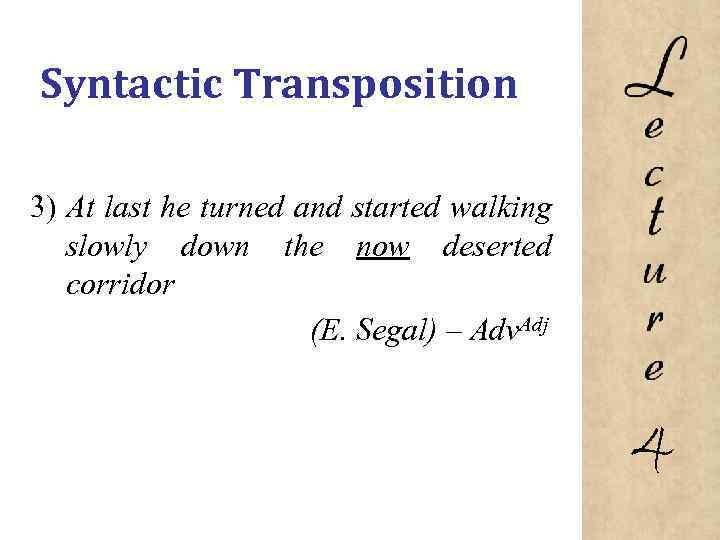
Syntactic Transposition 3) At last he turned and started walking slowly down the now deserted corridor (E. Segal) – Adv. Adj 4
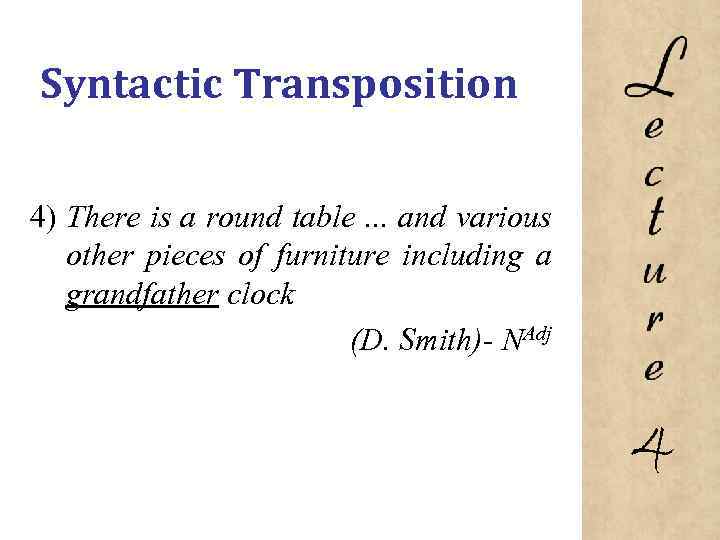
Syntactic Transposition 4) There is a round table. . . and various other pieces of furniture including a grandfather clock (D. Smith)- NAdj 4
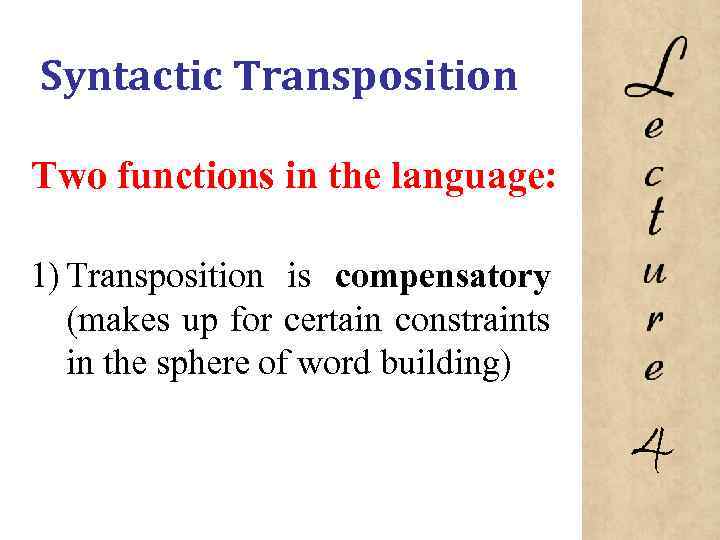
Syntactic Transposition Two functions in the language: 1) Transposition is compensatory (makes up for certain constraints in the sphere of word building) 4
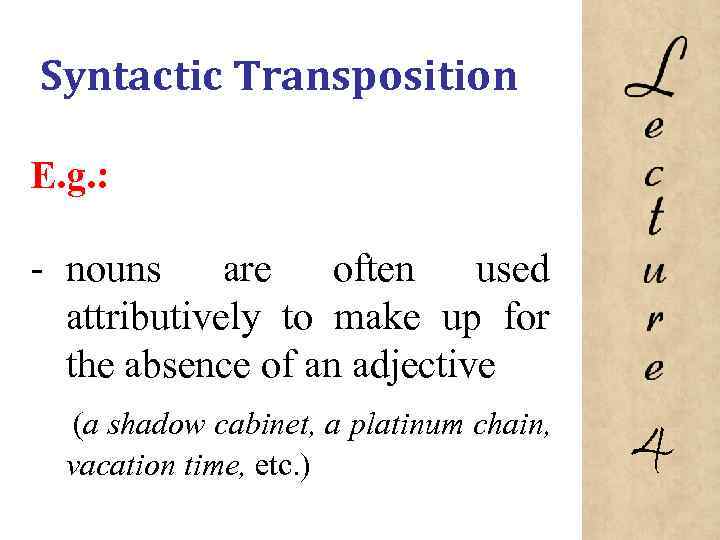
Syntactic Transposition E. g. : nouns are often used attributively to make up for the absence of an adjective (a shadow cabinet, a platinum chain, vacation time, etc. ) 4

Syntactic Transposition the adverbial nouns way and manner are often transposed into adverbial sphere to make up for the absence of a corresponding adverb After a week we all served ourselves Chinese style, standing and stretching across the table one after another (L. Hobbs) 4
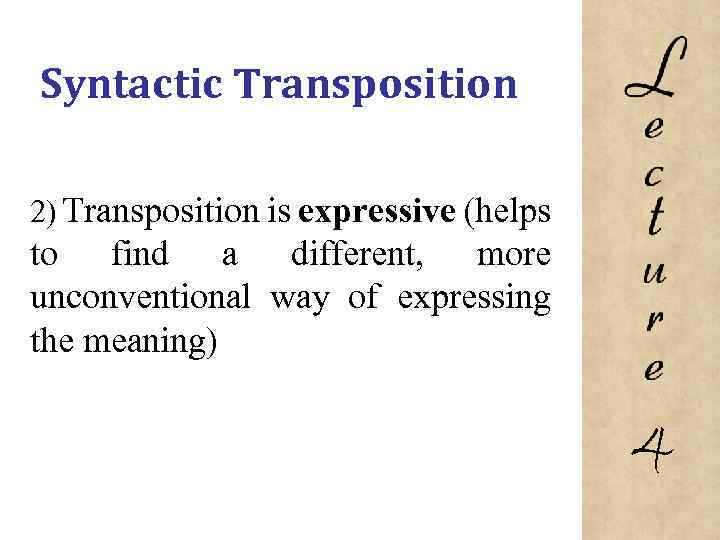
Syntactic Transposition 2) Transposition is expressive (helps to find a different, more unconventional way of expressing the meaning) 4
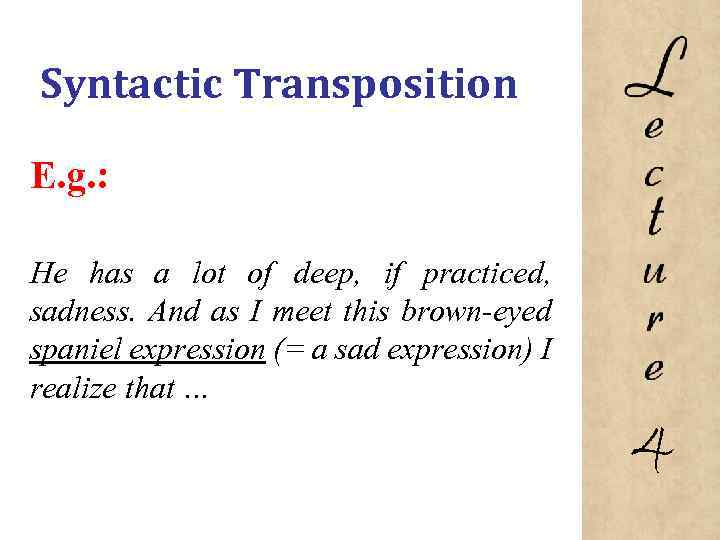
Syntactic Transposition E. g. : He has a lot of deep, if practiced, sadness. And as I meet this brown-eyed spaniel expression (= a sad expression) I realize that … 4
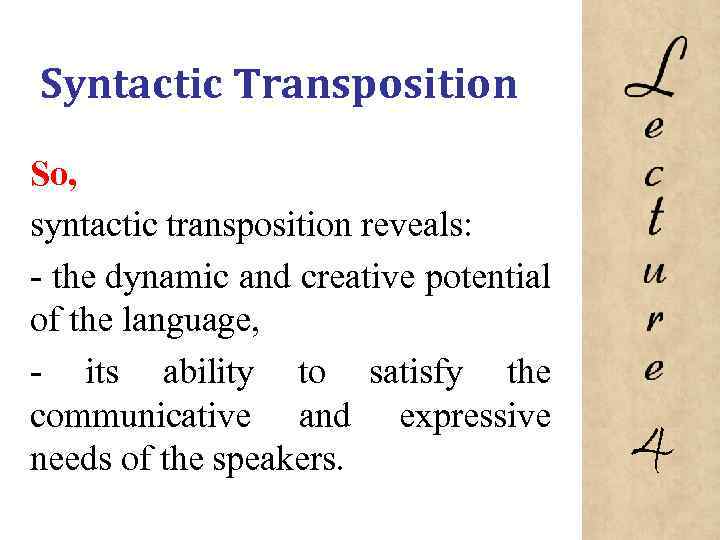
Syntactic Transposition So, syntactic transposition reveals: the dynamic and creative potential of the language, its ability to satisfy the communicative and expressive needs of the speakers. 4
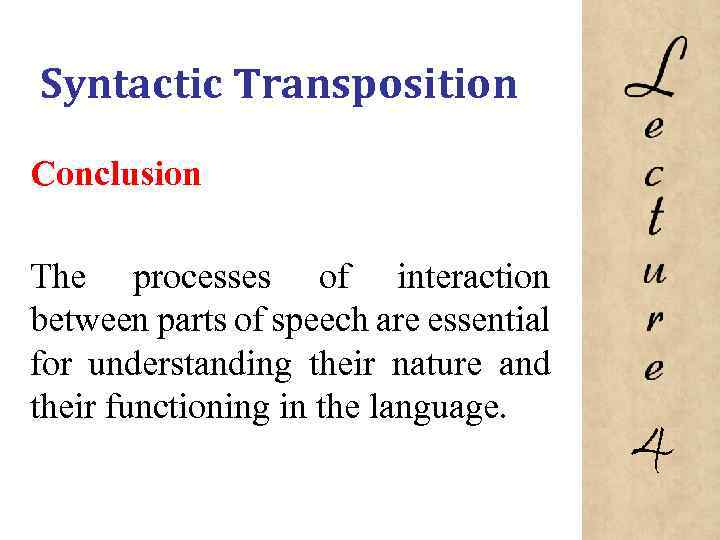
Syntactic Transposition Conclusion The processes of interaction between parts of speech are essential for understanding their nature and their functioning in the language. 4

Lecture 4 (The Problem of Parts of Speech).pptx